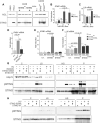Innate immunity mediator STING modulates nascent DNA metabolism at stalled forks in human cells
- PMID: 36710880
- PMCID: PMC9877313
- DOI: 10.3389/fmolb.2022.1048726
Innate immunity mediator STING modulates nascent DNA metabolism at stalled forks in human cells
Abstract
Background: The cGAS/STING pathway, part of the innate immune response to foreign DNA, can be activated by cell's own DNA arising from the processing of the genome, including the degradation of nascent DNA at arrested replication forks, which can be upregulated in cancer cells. Recent evidence raises a possibility that the cGAS/STING pathway may also modulate the very processes that trigger it, e.g., DNA damage repair or processing of stalled forks. Methods: We manipulated STING levels in human cells by depleting or re-expressing it, and assessed the effects of STING on replication using microfluidics-assisted replication track analysis, or maRTA, a DNA fiber assay, as well as immuno-precipitation of nascent DNA, or iPOND. We also assessed STING subcellular distribution and its ability to activate. Results: Depletion of STING suppressed and its re-expression in STING-deficient cancer cells upregulated the degradation of nascent DNA at arrested replication forks. Replication fork arrest was accompanied by the STING pathway activation, and a STING mutant that does not activate the pathway failed to upregulate nascent DNA degradation. cGAS was required for STING's effect on degradation, but this requirement could be bypassed by treating cells with a STING agonist. Cells expressing inactive STING had a reduced level of RPA on parental and nascent DNA of arrested forks and a reduced CHK1 activation compared to cells with the wild type STING. STING also affected unperturbed fork progression in a subset of cell lines. STING fractionated to the nuclear fractions enriched for structural components of chromatin and nuclear envelope, and furthermore, it associated with the chromatin of arrested replication forks as well as post-replicative chromatin. Conclusion: Our data highlight STING as a determinant of stalled replication fork integrity, thus revealing a novel connection between the replication stress and innate immune responses.
Keywords: STING; human; hydroxyurea; innate immunity; nascent DNA; replication.
Copyright © 2023 Lazarchuk, Nguyen, Brunon, Pavlova and Sidorova.
Conflict of interest statement
The authors declare that the research was conducted in the absence of any commercial or financial relationships that could be construed as a potential conflict of interest.
Figures








Similar articles
-
Stalled replication fork protection limits cGAS-STING and P-body-dependent innate immune signalling.Nat Cell Biol. 2022 Jul;24(7):1154-1164. doi: 10.1038/s41556-022-00950-8. Epub 2022 Jul 11. Nat Cell Biol. 2022. PMID: 35817959 Free PMC article.
-
Lamin A/C recruits ssDNA protective proteins RPA and RAD51 to stalled replication forks to maintain fork stability.J Biol Chem. 2021 Nov;297(5):101301. doi: 10.1016/j.jbc.2021.101301. Epub 2021 Oct 11. J Biol Chem. 2021. PMID: 34648766 Free PMC article.
-
cGAS suppresses genomic instability as a decelerator of replication forks.Sci Adv. 2020 Oct 14;6(42):eabb8941. doi: 10.1126/sciadv.abb8941. Print 2020 Oct. Sci Adv. 2020. PMID: 33055160 Free PMC article.
-
[SAMHD1 acts at stalled replication forks to prevent interferon induction].C R Biol. 2020 Jun 5;343(1):9-21. doi: 10.5802/crbiol.10. C R Biol. 2020. PMID: 32720483 Review. French.
-
Replication stress: from chromatin to immunity and beyond.Curr Opin Genet Dev. 2021 Dec;71:136-142. doi: 10.1016/j.gde.2021.08.004. Epub 2021 Aug 26. Curr Opin Genet Dev. 2021. PMID: 34455237 Review.
Cited by
-
TRDMT1 methyltransferase gene knockout attenuates STING-based cell death signaling during self-extracellular RNA-mediated response in drug-induced senescent osteosarcoma cells.Cell Mol Life Sci. 2025 Aug 13;82(1):310. doi: 10.1007/s00018-025-05835-1. Cell Mol Life Sci. 2025. PMID: 40801921 Free PMC article.
-
A noncanonical cGAS-STING pathway drives cellular and organismal aging.Proc Natl Acad Sci U S A. 2025 Jul 15;122(28):e2424666122. doi: 10.1073/pnas.2424666122. Epub 2025 Jul 10. Proc Natl Acad Sci U S A. 2025. PMID: 40638086 Free PMC article.
-
James German and the Quest to Understand Human RECQ Helicase Deficiencies.Cells. 2024 Jun 21;13(13):1077. doi: 10.3390/cells13131077. Cells. 2024. PMID: 38994931 Free PMC article. Review.
-
Evaluation of two new antibodies for recognition of CldU in DNA fiber assay applications.MicroPubl Biol. 2025 Jan 31;2025:10.17912/micropub.biology.001485. doi: 10.17912/micropub.biology.001485. eCollection 2025. MicroPubl Biol. 2025. PMID: 39958910 Free PMC article.
References
Grants and funding
LinkOut - more resources
Full Text Sources
Research Materials
Miscellaneous

